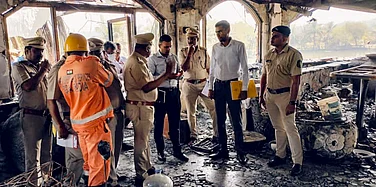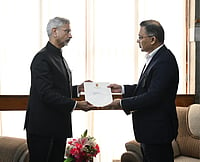Sikandar Sharma, a sugarmill worker, was among the 30 bus passengers kidnapped on October 20, 1995 from near Bettiah in Bihar. They were herded by a 15-strong gang into the vast expanse of sugarcane fields where they were beaten up with rifle butts.
But unlike the others Sharma got away. "I ran under cover for a whole night through the sugarcane fields and in the morning I saw a metalled road and found my way home," Sharma said, hours after his successful getaway. The rest were not so lucky. They were freed a whole week later after a hefty ransom was paid, although the police claim they were rescued.
Kidnapping for ransom, which is emerging as Bihar’s largest industry, has its origins in the WestChamparan district headquarters of Bettiah, situated in the northwest of Bihar. In fact, according to police records, two persons are abducted every day in Bettiah. This year alone, there have been close to 200 abductions. And this is a conservative estimate because many people do not file FIRs. For doing so could mean a higher ransom the next time they are kidnapped.
Dutta Treynath Tiwari, 55, says that when he was first abducted in August 1989, he lodged a complaint with the police. When he was picked up again by the outlaws, they remembered that he had gone to the police the first time round. "So I had to cough up more money," he informs, without disclosing exactly how much.
"Given the local topography, kidnapping has become a way of life here," admits the district magistrate, Aditya Swaroop. Local officials say that there are five major gangs in almost every region in Bihar, including West Champaran. But the gangs rarely do the dirty work themselves any more and find it equally lucrative to leave the task to sub-gangs who operate on contracts, abducting for a pre-determined share of the loot.
Lal Babu Kaushal from Bagha in West Champaran says he was picked up on August 26 this year, taken to a nearby forest and ‘sold’ for an unspecified sum of money to another gang. "They left me after realising that I was a social worker," he says, pointing to his gun.
The prime targets of most kidnappers are naturally businessmen. So much so that in Bettiah and Champaran, there is not a single businessman who hasn’t been abducted. Says Jagdish Kishan, a tyre dealer and shopowner: "We don’t follow any routine. We change rooms every day. I have armed guards whenever I travel, even from my house to my shop." Incidentally, Kishan, who is the president of the Lal Bazaar Market Association in Bettiah, was shot at in 1992 when he refused to pay ransom.
And since the kidnappers choose their prey across the classes, no one is safe. This accounts for the existence of absentee farmers—landowners and landless workers alike—who only return to their villages for the harvest season and seek refuge in safer regions for the rest of the year.
Kidnapping came to Bettiah in 1980, and by 1985 it had spread to Rohtas, Bhagalpur and Munger districts. These districts have one thing in common: their topography is either hilly or riverine, making escape from the law so much easier. In fact, in the early ’80s the district judge of neighbouring East Cha-mparan pinned the blame for the worsening law and order problems on the administration. By the late ’80s, kidnapping had acquired epidemic proportions. For instance, in the first five months of 1995, close to 700 persons have been abducted from various parts of the state. That makes it an average of nearly six kidnappings a day.
The types of ‘hits’ also vary. In Muzaffarpur and areas in north Bihar, there is an active student-contractor nexus. Most victims are perceived political rivals. In Munger and other riverine areas, the caste factor plays a significant role. With the emergence of powerful intermediary castes—in this case the Yadavs—gangs have spawned in Madhepura, Khagaria, Purnea and Sitamarhi, where the targets are the rich and the upper castes.
In some districts like Begusarai and Mokama, kidnapping has taken a different form. Young unwilling men are picked up and married off at gun point. The reason: escalating demands for dowry. According to a study by Haribansh Prasad of Patna’s A.N. Sinha Institute, in 1994, there were nearly 50 such abductions in the two districts.
The activity is not limited to professional groups. For good measure, they are joined by some fringe groups and have managed to strike in Palamau, Aurangabad and some areas of Chhota Nagpur in south Bihar. In south-west Bihar, protected by the inaccessible Kaimur hills, gangs alternate freely between Bihar, Uttar Pradesh and Madhya Pradesh. Given the miserable unemployment rates—up to 55 per cent—the ground is more than fertile for able-bodied men to make a quick buck.
As for the ransoms, there is no hard and fast rule and they vary with the paying capacity of the abducted. While the normal range is from a few thousand rupees to Rs 10 lakh, in one case from Bhagalpur, a 15-year-old boy was returned not for money but after a hearty ransom dinner was organised for the kidnappers. Says the Bihar Director General of Police, G.P. Dohre: "We are trying hard to fight the trend. Developments in several districts are being monitored."
However, the reality is quite different. There are only one lakh men policing a population of more than 12 crores. Even senior officials admit that the integrity of some of them is doubtful. And as S.N. Mitra, president of the Bettiah Bar Association, points out: "People are given bail indiscriminately."
In addition, there is a clear lack of political will. Officials say most gangs have direct political patronage. Some gangs claim that their leaders have access to even Chief Minister Laloo Prasad Yadav’s official residence. There is the classic case of a doctor from Patna who, after his car was taken away at gun point, reached Laloo’s residence to find it parked there. "How do you explain the rise in Yadav gangs in the last five years?" questions a member of the Bihar Chamber of Commerce.
But while there is no doubting the political patronage, it would be simplistic to fix the blame on one party. And as observers note, kidnapping really flourished in the 1980s under the Congress regime.
However, the situation is not exactly lost and a few good men, as it were, could turn the tide. This was demonstrated by Ramchandra Khan, Bihar’s most celebrated police officer who literally wiped out kidnapping between 1985 and 1988 in Bettiah. From 1980 to 1984, there were 145 abductions. This was scaled down to 36 during the three years he spent there. But since his departure, it’s been downhill again.
"You need good officers," Khan says modestly. What he declines to say is, you need good politicians, too.


























